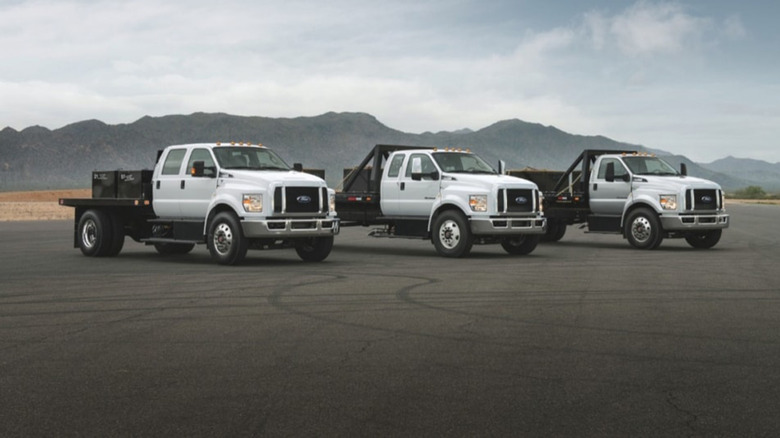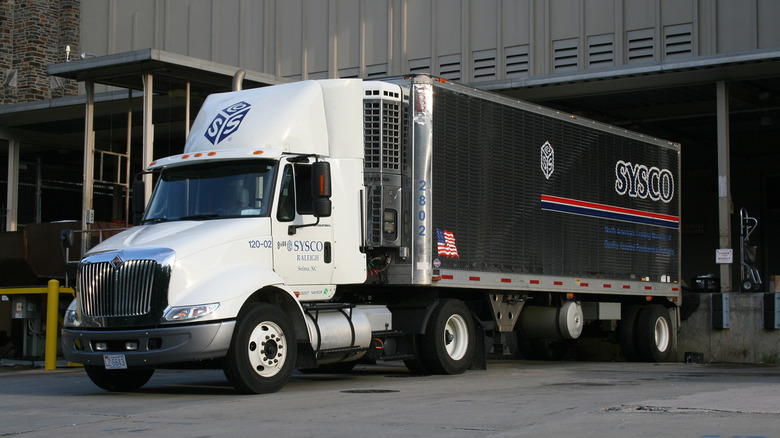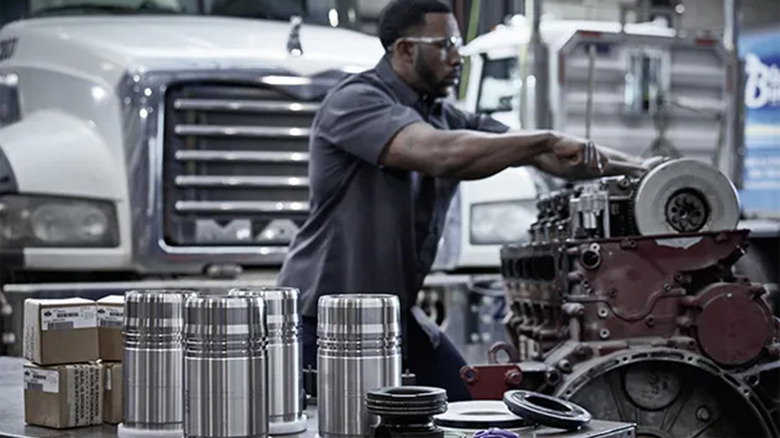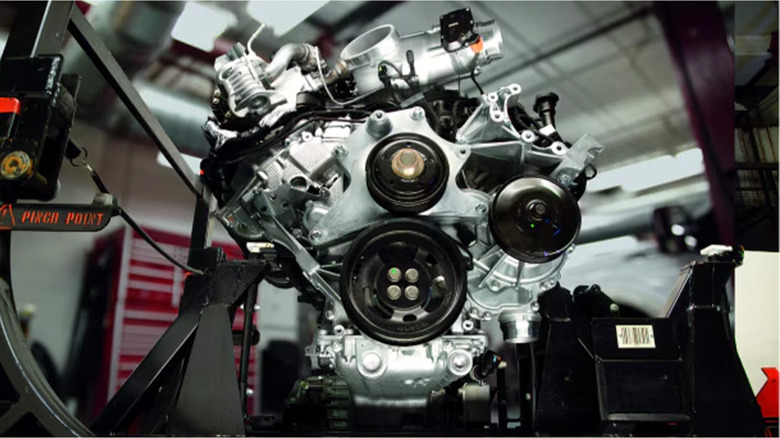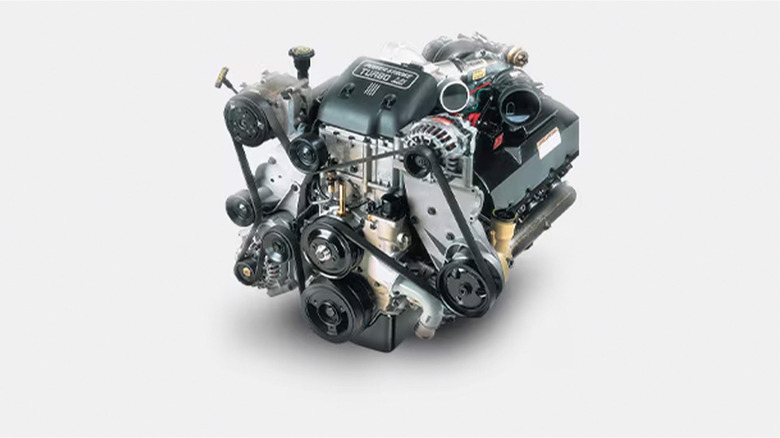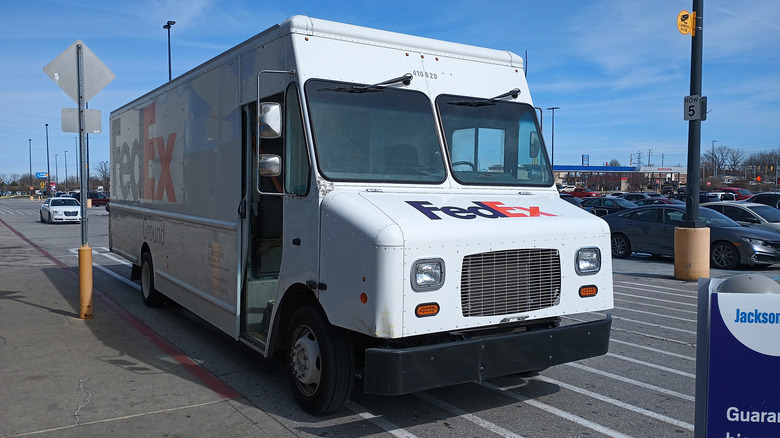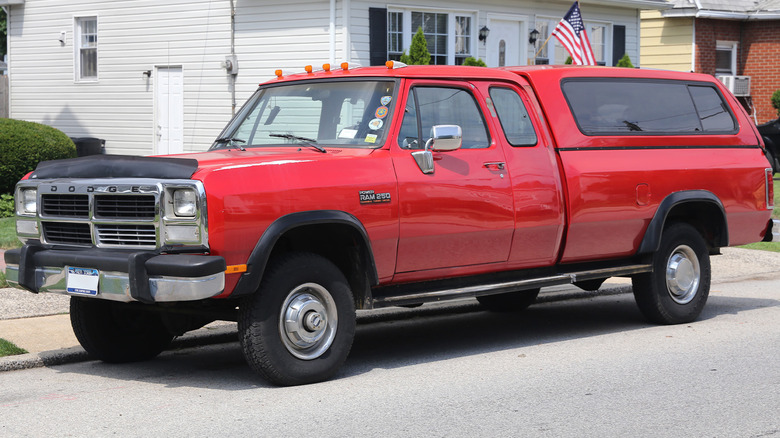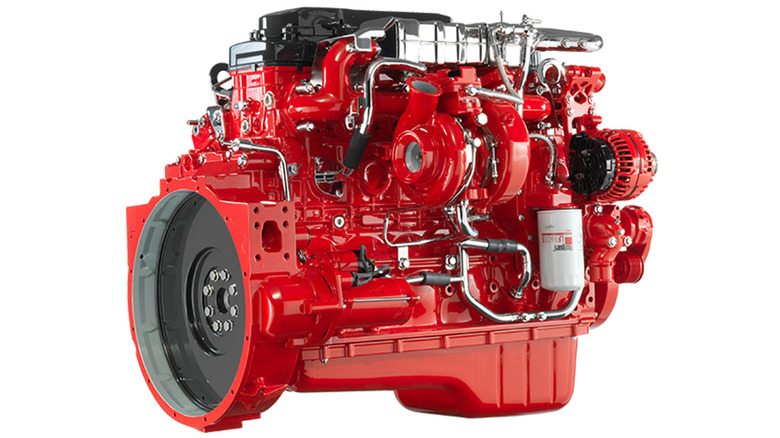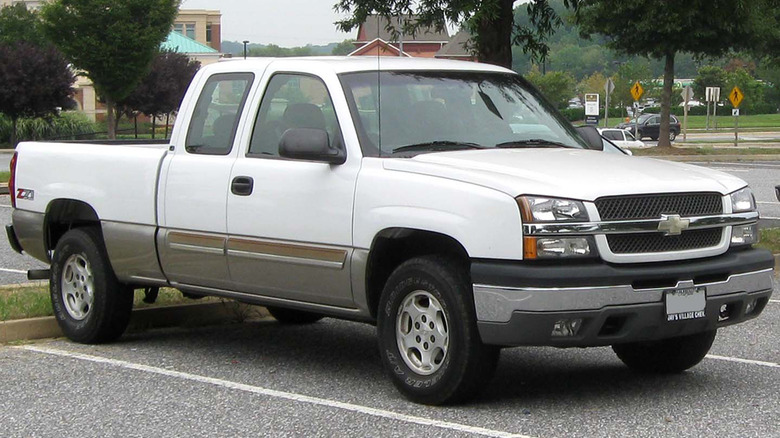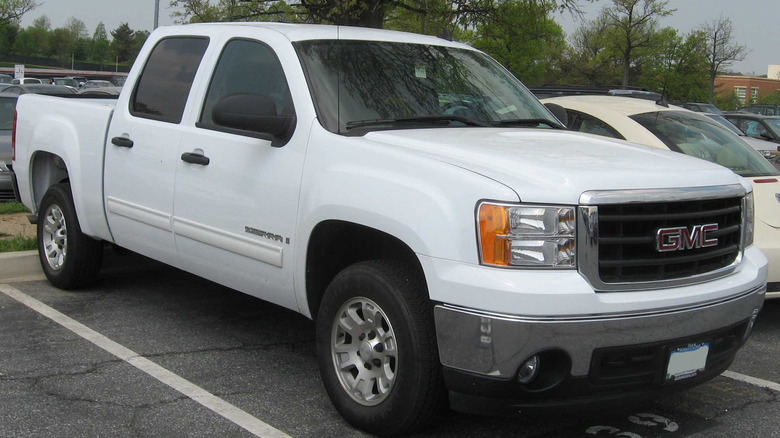9 Of The Best Diesel Engines Ever Made By American Companies
It's no secret that diesel engines aren't nearly as popular in the U.S. as they are in Europe and other markets. Reasons for this range from the disaster that was GM's attempt at diesel engines in the 1980s, to the oft-repeated notion that they're loud, smell bad, and pollute heavily via nitrogen oxides. In reality, the diesel engine is also much more fuel efficient, and modern engines have reduced nitrogen oxide pollution substantially. However, you're more likely to find a diesel engine-equipped car in Europe than you are in the States.
There is an exception to this rule: work vehicles. Tons of work vehicles in the U.S. use diesel engines, and that's where most of the diesel engine tech goes these days. Tractors, semi-trucks, box trucks, and other larger trucks run diesel engines all the time and for good reason. Diesel engines are known to last an exceptionally long time provided that there isn't a defect in the design. The extra fuel efficiency and crazy torque numbers also help those larger trucks pull whatever heavy cargo the operator needs it to pull.
So, while the diesel engine is much more well-known in Europe, plenty are also made here in the U.S. as well. You may notice them every day, but they're definitely around.
Navistar DT466
Let's start with one of the most legendary diesel engines ever constructed in any country. The Navistar DT466, built by International, was around for a long time and shoved into all sorts of vehicles. It started life in 1971 as a tractor engine before being redesigned for highway use in 1975. From there, it was stashed in tractors, trucks, buses, and even some military vehicles for decades. It was finally discontinued in 2016 after 45 years of dutiful service. Given its long production life and myriad applications, it's almost a guarantee that you've seen a vehicle powered by one of these engines before.
Along with its long production life, multiple variants, and wide applications, the engine was also known to be nearly unkillable. In some cases, engines are rated with something called a B-Life rating, which is a predictor of how many engines in a lineup will fail by the time it reaches a certain mileage. The DT466 had a B50 rating of 550,000 miles. That means by 550,000 miles, approximately 50% of DT466 engines will need some sort of major repair. That is excellent and only a handful of commercial engines can do better.
The DT466 underwent tons of revisions over the years. Some of them include a change to HEUI injection instead of mechanical injection, plenty of modifications to reduce emissions, and more. However, the engine is perhaps best known for its wet sleeve design, which revolutionized the diesel engine in the 1970s.
Mack E7
Most people know Mack as a well-known player in the semi-truck industry. One of the reasons for that is because the company can produce a pretty decent engine that helps its trucks last a long time. One of those engines is the Mack E7. It was introduced in 1988 in four configurations for various uses. These engines have been shoved into industrial machines, farming equipment, mining equipment, trucks, and plenty of other things. The company had 16 variants of the engine by 1999 for all of the various use cases that people needed. In all, Mack produced the engine for a little over 20 years.
Much like the DT466, the E7 is virtually unkillable if you take good care of it. We saw several stories online of folks with E7-equipped trucks that had north of 1.5 million miles on them. Some of those trucks hauled heavy shipping containers every day. Since many of its uses are for equipment that doesn't necessarily drive, mileage reports are fairly difficult to find but the engine certainly has its fans. It has been called by some as one of the most popular industrial diesel engines ever made.
The Mack E7 also had some ridiculous specs to back up its absurd reliability. At its most powerful, the engine reportedly made around 454 hp and 1,660 lb-ft of torque. That's a little more torque than the most powerful Dodge engine ever built has horsepower. Basically, this thing could probably pull a house off of its foundation.
Ford 6.7-liter Power Stroke Diesel
The Ford 6.7-liter Power Stroke Diesel engine may not get the same love as the brand's gasoline engines, but it's still one of the better engines the Blue Oval has made. The history of this diesel monster is still in ongoing, because the engine is still in use today. It joins the 7.3-liter diesel as an iconic diesel engine for Ford trucks, and we'll talk about that 7.3-liter shortly. At its maximum, the 6.7-liter Power Stroke can produce 450 hp and up to 1,050 lb-ft of torque.
Its power figures are one of the reasons the engine is so good. Ford has popped this thing into many of its larger trucks over the years ranging from the F-250 Super Duty all the way up to the F-750. When properly equipped, a Ford F-450 can tow upwards of 40,000 pounds with the 6.7-liter power stroke. That is approximately half of an average house's worth of weight. The engine also generally considered reliable, even though the earlier revisions had some issues that Ford eventually ironed out. Thus, if you find your way into a newer Power Stroke, you'll likely have better luck.
Unlike many of the commercial diesel engines on the list, Ford mostly just puts this in their F-series trucks. However, those trucks are often used as utility trucks, ambulances, dump trucks, box trucks, and other commercial vehicles. You've almost certainly driven by a Ford 6.7-liter Power Stroke before if you travel often.
Navistar/Ford 7.3-liter Power Stroke
Preceding Ford's 6.7-liter Power Stroke, a joint effort between the automaker and International created the Navistar and Ford 7.3-liter Power Stroke engine. As the story goes, Ford was making its own diesel engines at the time but partnered with International to make this engine starting in 1994. It's based on the Navistar T444E, which has a good reputation as well. The 7.3-liter is widely considered to be one of the best engines ever put into a Ford truck.
What makes this engine good is the same thing that makes the DT466 and 6.7-liter Power Stroke good. It lasts for a long time, it's comparatively easy to work on when it breaks down, and it can handle a lot of abuse. When it launched, it made more power than any other light-duty truck engine when it came out but has since been surpassed by newer engine technology. Even so, its 225 hp and 450 lb-ft of torque was nothing to sneeze at and a properly equipped truck can tow north of 10,000 pounds, which is competitive with some truck engines that are 20 years newer.
Ford ceased making the 7.3-liter diesel in 2003. After that, the Ford and Navistar went on to release the much less exciting 6.0-liter diesel and a 6.4-liter diesel before Ford split with Navistar. The 6.7-liter diesel listed above was built entirely in-house, leaving the 7.3-liter as arguably the best diesel engine to come out of the Navistar and Ford partnership.
Cummins 4BT
The 3.9-liter Cummins 4BT is an enigma among diesel engines. It's an excellent engine and has powered many things you've no doubt seen along your travels. Like many diesel engines, the 4BT powered things other than roadworthy vehicles. Some folks have even used them to power their boats. In addition, the engine has been known to power other industrial and agricultural equipment along with buses, bread vans, and box trucks. Among the most well-known is the humble FedEx box truck, some of which have been known to run a Cummins 4BT.
So what makes this engine so legendary? For starters, its applications are virtually endless. It can be used in equipment, boats, or road-going vehicles, and that alone makes it super useful. Despite its relatively meager power, the engine is also considered highly reliable and often used in engine swaps for all sorts of vehicles. The 16-valve version of the engine made 170 hp and 420 lb-ft of torque — not enough to win races, but plenty to scoot a box truck forward.
The enigma part comes due to timelines. Cummins began making the engine in 1983. It received a major revision in 1998 to the 4BTA. Cummins still makes this engine today as part of its ReCon series of engines, but a lot of details from the 2000s onward are exceedingly difficult to find. Rest assured, if you have a boat or a woodchipper that needs an engine, this is a good engine to start with.
Cummins 6BT
The Cummins 6BT has a lot in common with the 4BT, but is generally considered the superior of the two. For starters, the 6BT engine makes more power. The 5.9-liter inline six produces upwards of 215 hp and 440 lb-ft of torque, topping its smaller sibling in both categories. Of course, there are some caveats as well. While the engine does make more power, it's also over 300 pounds heavier and also much larger, which limits its potential use. You likely won't find as many 6BT engines in woodchippers as you do 4BT engines.
Despite its larger size and weight, the Cummins 6BT is still one of the best diesel engines ever. It's given partial credit for the revival of the Dodge pickup truck after its D-series pickups had fallen out of favor with the general public. At the time, the engine was more advanced than anything Ford or GM had. Pair that with the engine's general reputation for being nearly bulletproof and you have the ingredients for a legendary diesel engine. Like the 4BT, there were multiple variants of this engine, including the 6B, 6BT, and 6BTA.
Also, like the 4BT, Cummins technically never stopped selling the 6BT. You can still buy one today as part of Cummins ReCon series, making it one of the longest produced engines on the list. Somewhat ironically, the 6BTA on sale now is recommended for marine use. We hope your boat is big enough.
Cummins ISB 6.7-liter
The Cummins ISB 6.7-liter diesel is the final form of the Cummins diesel engine as of today. This 6.7-liter straight-six turbodiesel is the newest model in the Cummins B-series engine lineup, and has largely replaced the 4BT and 6BT in most applications. It was introduced in 2007, boasting a 13% increase in displacement and more modern diesel tech than the 5.9-liter 6BA. While Cummins still produces both engines, the ISB is the current flagship.
Since it is a B-series engine, it shares a lot of the same benefits as the others. It's quite reliable, with many examples online having north of 300,000 miles and sometimes more. By most counts, the 6.7-liter is an overall improvement on the 5.9-liter's design, which is a rarity in the engine space. After all, it took Ford two tries between its 7.3-liter and 6.7-liter Power Strokes to get things right again. The ISB 6.7-liter is also used in a variety of vehicles from Dodge Ram trucks to the 2016-19 Nissan Titan XD Diesel.
In short, the ISB 6.7-liter is good for the same reasons as the other two Cummins engines on the list. It's reliable, durable, and it has a variety of uses. Pair that with an impressive 420 hp and 1,075 lb-ft of torque, and you have a modern engine with tons of power that'll last you a long time. It's hard to beat that.
Duramax LB7 V8
The GM Duramax series of diesel engines are fun to talk about. Some of them have been outstanding engines while others have been among the worst diesel engines ever made. Among those is the LB7, which is largely considered one of the best Duramax engines ever built. GM built the engine between 2001 and 2004, giving the LB7 one of the shortest production lives of any diesel engine on the list. It also has the distinction of being the first fruit of a partnership between GM and Isuzu.
So, what made this engine great? The same stuff we've said a bunch of times. It was reliable, it was available, and it had enough power for its era to do the work it needed to do. Its one big issue seemed to be the fuel injectors, which tended to break around the 100,000-mile mark. Survive that repair and the engine was otherwise about as bulletproof as it gets. That's saying something given that this was GM and Isuzu's first effort. In any case, we were able to find several examples of the engines making it to 300,000 pretty easily with a couple of examples of this engine breaking the one-million-mile barrier.
Honestly, it's a pretty good first effort for the GM and Isuzu partnership. That fruitful partnership would last until 2016 when the brands agreed that jointly designing trucks was no longer a good idea. The LB7 was one of the better examples of the two companies working together.
Duramax LBZ V8
While the LB7 was a good overall engine, the Duramax LBZ V8 was arguably better. GM made the engine from 2006 to 2007, the shortest lifespan of any engine on this list. The LBZ replaced the LLY engine in GM's lineup, a model which was generally considered not very good due to overheating issues. At its peak, the engine made 360 hp and 650 lb-ft of torque, giving it decent numbers for its era.
Despite its short production life, the LBZ made a positive impact on GM shoppers. There are tons of anecdotal examples online of this truck cruising passed 200,000 miles and even 300,000 miles in some cases. Pair that durability with a reasonable amount of power for 2006-07 and the fact that these were readily available in both the Chevy Silverado HD and the GMC Sierra HD models for both years, and you have a recipe for success. Of course, all the positive stories may also have to do with a limited sample size since the engine was only available for two years, but we found it rather difficult to find a lot of negative stories about the LBZ.
The LBZ was among the last "dirty diesel" engines. The rollout of Ultra Low Sulfur Diesel in 2007, came with a government mandate that all new diesel engines had to run that fuel. This caused GM to swap to the LML engine, and it's also why Cummins, Ford, and other diesel makers all had new engines in 2007 specifically.
